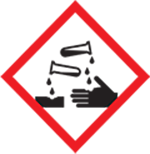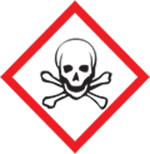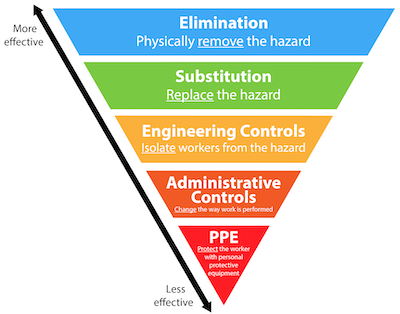Hydrofluoric Acid
This chemical standard operating procedure (SOP) and the associated Safety Data Sheet (SDS) are for our safety. Read and understand both documents. If this is a paper copy, check for updated versions on the IsoLab website.
Process
We use hydrofluoric acid in our kerogen extraction procedure to dissolve silicates and other oxides.
Hazards - SDS


Fatal if swallowed, in contact with skin or if inhaled. Causes severe skin burns and eye damage.
Protection - SDS

Engineering Controls
Hydrofluoric acid may only be used in a fume hood. Ensure the fume hood has proper air flow by checking the flow rate on the control panel and / or using a smoke match or wipe to visualize flow.
PHS - Use the fume hood in 302B when working with hydrofluoric acid. Hydrofluoric acid is not to leave 303B unless it is in its original container with a tightly closed lid.
Administrative Controls
PHS - Tell others in the lab that you are using hydrofluoric acid. Close the hydrofluoric acid lab door and make sure the HF sign is posted.
Personal Protective Equipment (PPE)
PHS - Use 22 mil (nominal) gauge Sol-Vex Nitrile, neoprene, butyl rubber, SilverShield gloves. Optional to use nitrile gloves as a second layer on top for dexterity. Do not use latex gloves. Dispose of gloves after each use. Wear goggles together with a face shield to protect the face and eyes from splashes. Wear a heavy rubber apron, Tyvek coveralls, lab coat and/or Tyvek sleeves to protect clothes and body. Wear closed-toe shoes to protect the feet. Ensure gloves are thoroughly washed after use, even if no visible contamination exists.
Handling - SDS
Keep container tightly closed when not in use. When actively dispensing and handling hydrofluoric acid, work must remain inside the fume hood in 303B. If hydrofluoric acid is to leave the fume hood, it must be contained in a tightly closed container. Do not use glass or metal containers or tools to work with hydrofluoric acid.
PHS - Decontamination - Thoroughly rinse all plastic containers inside the fume hood that came in contact with hydrofluoric acid. Use calcium carbonate (not sodium bicarbonate) as needed to neutralize.
Storage - SDS
Hydrofluoric acid must be stored in the corrosives cabinet under the 302B fume hood. Use MyChem, the UW EH&S chemical inventory database, for more storage information. Store tightly closed bottles in the secondary container in the corrosives cabinet.
Spills - SDS
Outside Fume Hood Spill - FUMES - Everyone should evacuate. If you intend to clean up the spill yourself, don a respirator with a gas vapor cartridge and non-vented protective goggles along with all other PPE described above before attempting clean-up. Do not let anyone enter the contaminated space until the air is cleared or proper PPE has been donned.
PHS - Exposure:
- Inhalation - Remove person to fresh air and keep comfortable for breathing. For advice, call UW Employee Health Center (206.685.1026) or the Washington Poison Center (800.222.1222). For emergency help, call 911.
- Skin contact - Remove clothing and rinse for five minutes in the safety shower. Gently wash with plenty of soap and water. Apply calcium gluconate gel to the skin. For advice, call UW Employee Health Center (206.685.1026) or the Washington Poison Center (800.222.1222). For emergency help, call 911.
- Eye contact - Rinse cautiously with water for several minutes. Remove contact lenses, if present and easy to do. Continue rinsing. Do not apply calcium gluconate gel to eyes. For advice, call UW Employee Health Center (206.685.1026) or the Washington Poison Center (800.222.1222). For emergency help, call 911.
Inside Fume Hood Spill - If the spill is fully contained inside the fume hood, close the sash and prepare yourself to clean it up. Grab the closest spill kit. Make sure you have donned all the above-described appropriate PPE. Do not allow the substance to enter the drain. Use liquid-absorbent material to soak up the chemical. Put all generated waste into a bag. See Waste section below.
If you need assistance or advice, use the IsoLab Emergency Contacts sheet.
Consult the EH&S Spill Poster and Exposure Poster
Waste - SDS
If you are cleaning up after a spill and have a bag of debris, ensure the bag is sealed and use multiple bags as needed. Complete an EH&S Hazardous Waste Label and adhere it to the bag. Here are instructions for how to label chemical waste containers. Labels are located in a drawer on the west wall of 303B near the door to the hallway.
Put all waste, solid or liquid, into a plastic container. Options for waste containers can be found under the west sink in 303B. Complete an EH&S Hazardous Waste Label and adhere it to the bottle. Here are instructions for how to label chemical waste containers. Labels are located in a drawer on the west wall of 303B near the door to the hallway.
Place the properly labeled container in one of the gray tubs near the hallway door of 303B. Segregate from other waste containers as appropriate.
Consult our generalized Chemical Waste Disposal SOP.

Training - PHS
Hydrofluoric acid is deemed a particularly hazardous substance - PHS by EH&S and you need approval before using it. Complete the list of requirements below before using this chemical.
Prerequisites
- You must have completed Managing Laboratory Chemicals in the last three years. Login to check.
- Complete the EH&S course specific to hydrofluoric acid.
- Read and understand the SDS for hydrofluoric acid.
- Read and understand the EH&S hydrofluoric acid focus sheet.
- Read, understand, and digitally sign this SOP.
- Contact your Principal Investigator (PI) AND the Chemical Hygiene Officer (CHO) indicating that you have completed all prerequisites and await approval.
